Content
Pepper diseases have different origins, but are equally capable of causing serious damage to the crop. In order to begin treatment of ailments in a timely manner, it is necessary to become familiar with their symptoms.
What diseases do peppers have?
Pepper diseases can be divided into several categories based on their origin:
- fungal;
- viral;
- bacterial.
A separate group includes non-infectious diseases. They arise due to violations of agricultural practices or difficult weather conditions and damage even completely healthy plants.
Fungal diseases of bell pepper with description and photo
Most often, bell peppers in the garden suffer from fungal diseases. They usually develop on waterlogged and acidified soils, since such an environment is most favorable for pathogens.
Blackleg
Blackleg is a fungal disease of pepper in the soil that develops in the top layer of soil when waterlogged, thickened plantings and low temperatures. You can recognize the disease by the dark constrictions on the root collars, due to which the plants lay down and die. The stem, under the influence of the black leg, acquires a dark green, gray or whitish tint.
Once constrictions occur, it is usually impossible to cure the disease. But for prevention, it is recommended to spray the crop with Fundazol and Fitosporin according to the instructions.

Blackleg usually affects peppers at the seedling stage before the true leaves appear.
Gray rot
Gray mold fungus affects most vegetable crops, including bell peppers. It is characterized by high endurance, survives in the soil on plant debris even in frosty winters. It appears with the onset of warm weather as gray velvety necrotic spots on the leaves and stems. Most often it occurs at a temperature of about 20 ° C in rainy weather with a lack of sunlight and affects the crop during the flowering and fruiting period.

Gray mold develops when there is a lack of potassium and calcium in the soil.
Pepper disease can be treated in the early stages with fungicides Amistar, Signum and similar. Spraying is carried out four times at intervals of a week.
White rot
White rot develops mainly on peppers growing in a greenhouse.It affects stems, leaves and fruits, manifesting itself as watery spots that quickly become covered with a cottony light coating. Over time, black dots of spores appear on the surface of the latter. White rot can lead to significant yield losses at the fruit ripening stage.
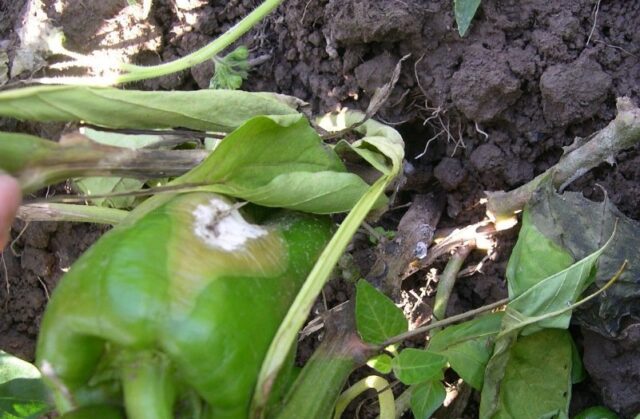
White rot develops especially often at temperatures around 22 ° C
When symptoms of the disease appear, affected plants must be removed. In autumn, the soil on which the bushes grew is treated with chemicals to destroy the remaining spores.
Late blight
A common pepper disease leaves brown spots on the leaves and stems of the plant, which eventually spread to the fruit and damage the crop. The disease often spreads to plantings from other crops or develops on poor soil with a deficiency of microelements.
To prevent late blight, bushes need to be treated with fungicides and homemade preparations containing manganese and iodine. Plantings are protected from the development of disease by potassium-copper fertilizers. If the plants have already been damaged by the fungus, they must be removed from the site and burned.

To prevent late blight, it is recommended to plant peppers away from other Solanaceae.
Anthracnose
A fungal disease of sweet pepper on the leaves appears on acidic soils with a lack of phosphorus and potassium and against the background of high air temperatures. The plates become covered with brown marks with a brown border; over time, the spots spread along the stems and fruits, merging and deepening. Pepper ceases to receive nutrients in the required volume and quickly fades.
If affected by the disease, it is necessary to remove the affected parts or entire bushes.For prevention and treatment, the culture is sprayed with Bordeaux mixture or copper oxychloride, as well as with preparations containing sulfur.

Anthracnose on pepper develops most often in a greenhouse
Fusarium
The disease affects the plant’s vascular system and disrupts nutritional processes. The disease can be recognized by blackening of the base of the stem, wilting of the upper leaves and slow development of the crop. If there is no fight against the fungus, the bushes gradually die, and necrotic dark pits may appear around the root collar.
With minor damage, the drugs HOM, Abiga-Pik and Quadris can be used to treat sweet pepper disease. If the plant is seriously damaged, it is worth removing it from the site and spraying the remaining plantings.

With fusarium, pepper leaves first lose turgor, and then change color and dry out
Alternaria blight
A fungal disease usually develops on peppers during the ripening period. Leaves round spots with a black velvety coating, the fruits become unfit for consumption.
The disease occurs in hot weather with light rains and air temperatures above 25 °C. Most often, plants with mechanical damage or sunburn suffer from the fungus - pathogenic spores easily penetrate their tissues.
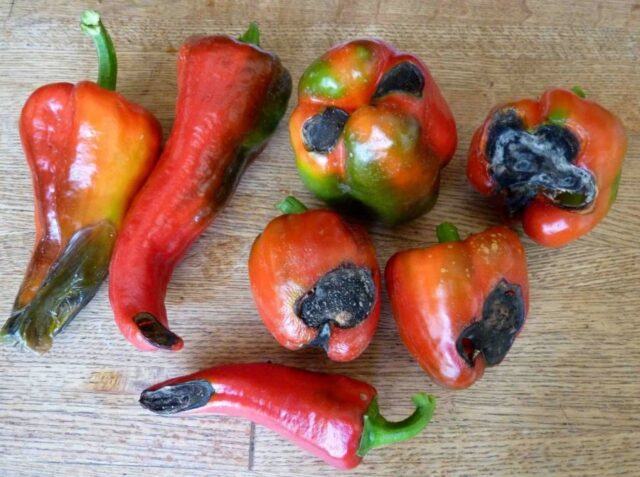
Alternaria blight progresses on pepper even after harvest
Cladosporiosis
The disease usually appears on greenhouse pepper bushes. You can recognize it by brown spots on the upper side of the leaf blades and a gray coating on the lower surface. If left untreated, it causes rot of the fruit and the stem itself.
In the early stages, the development of cladosporiosis can be stopped by spraying with Fundazol and other fungicides.It is also recommended to reduce the intensity of watering and pay increased attention to ventilating the bushes.

Spots with cladosporiosis quickly turn into holes on the leaves
Powdery mildew
Powdery mildew develops on peppers in hot weather with low air humidity. Large whitish spots with a dry coating appear on the upper side of the plates of the plant; over time, the leaves become deformed and dry out.
The fight against the disease is carried out with copper preparations, and severely damaged bushes are eliminated from the beds. To prevent powdery mildew, it is necessary to pay attention to regular watering and irrigation.

Powdery mildew reduces the yield of pepper bushes
Verticillium wilt
A fungal disease appears on peppers shortly before the fruits ripen or immediately during harvest. The lower leaves of the plant turn yellow and lose their elasticity; yellow, orange or brownish spots appear between the veins or along the edges. Over time, the plates fall off and the pepper completely dies.
The fungus develops most actively on light soils with low calcium content at a soil temperature of about 21 ° C. For prevention, it is necessary to timely feed plants with mineral fertilizers and disinfect the soil on the site in the autumn. Treatment of bell pepper disease in the early stages is carried out with the drugs Fitosporin and Fundazol.

Pepper verticillium often appears against the background of an excess of nitrogen in the soil
Bacterial diseases of sweet peppers with descriptions and photos
Bacterial diseases most often harm pepper bushes with mechanical damage to the roots and stems. Pathogenic microorganisms penetrate plant tissues and lead to their death.
Lightning Wither
The bacterial disease manifests itself as a slimy white discharge from the stem. The pepper quickly turns yellow and begins to wither, blockage of blood vessels occurs, which disrupts the access of nutrients to the plant tissue.

Lightning wilt can destroy peppers in 2-3 days
It is difficult to cure fulminant wilt, but spraying with copper sulfate helps in the very first stages. To prevent the disease, it is necessary to follow the rules of crop rotation and not plant peppers in one place for more than two years in a row.
Black bacterial spot
The disease usually manifests itself at a temperature of about 30 ° C with high humidity. Yellowish spots with a dark border form on the pepper leaves; gradually the marks themselves turn black, and the border becomes light in color. Convex dots appear on the fruits, which over time turn into sores with a clear rim.

Pepper fruits with black bacterial spot rot from the inside
The disease affects pepper at any stage of the growing season - from the first shoots to harvest. You can cope with the disease in the early stages with the drugs Gamair and HOM; it is better to completely destroy severely damaged bushes.
Soft rot
Soft rot appears on peppers in humid weather with insufficient ventilation of the plantings.The leaves of the plant turn pale, the stem becomes empty from the inside and withers, and watery circles appear on the above-ground parts, pressed inward.
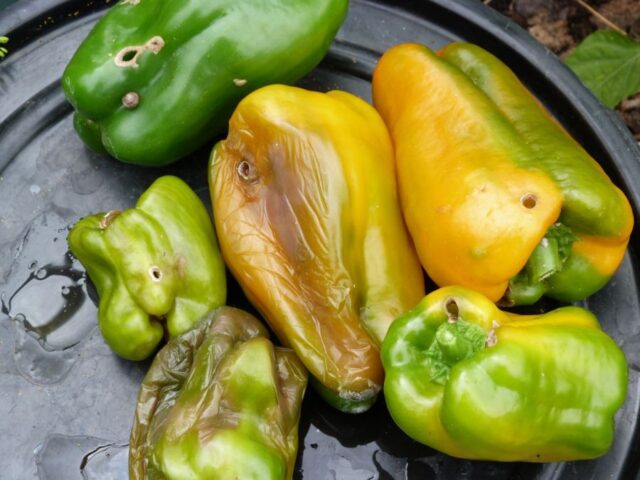
Peppers that have already been harvested from the garden may also suffer from soft rot.
To prevent the disease, it is recommended to water the pepper with Fitosporin-M at the planting stage. Ripe fruits are carefully sorted and stored in a dry place with good ventilation.
Bacterial cancer
Peppers most often suffer from bacterial cancer in rainy and hot weather. The disease can be recognized by depressed spots with a dark core on the fruits and by brown marks with a light center on the leaves.
The fight against bell pepper disease comes down to treating the plantings with copper sulfate twice a day until the symptoms disappear. When sowing, it is recommended to soak the seeds of the crop in a solution of Fitolavin-M 0.2%.

Bacterial canker usually affects peppers in the southern regions
Viral infections
Viral diseases pose a great danger to pepper. Most of them cannot be treated, so if the corresponding symptoms occur, the bushes simply have to be destroyed.
Leaf curl
With the curl virus, peppers do not always die, but their leaves become deformed and curled, the shoots are shortened, and the fruits become smaller. In some cases, the bushes remain green, in others they turn yellow and fade over time.
The disease spreads to the crop from weeds or is carried by pests. To prevent curling, it is necessary to keep the area clean and eliminate insects in a timely manner.

Peppers that are infected with the curl virus gradually degenerate
Tobacco mosaic
This dangerous disease leaves yellowish patterns on the leaves and slows the growth of pepper bushes. The fruits of the crop are becoming smaller, the harvest volumes are falling. Mosaic symptoms are strongest in early spring and late autumn. The virus spreads through gardening tools or in close proximity to other infected crops.

To prevent mosaic, it is recommended to grow pepper varieties that are resistant to this disease.
There is no cure for pepper leaf disease. But a good prevention of mosaic is to disinfect the seeds in a weak solution of sodium hypochlorite.
Stolbur (phytoplasmosis)
In dry, hot weather, pepper bushes may suffer from stolbur, or phytoplasmosis. The upper leaves of the crop turn yellow and curl, the flowers become sterile and fall off. Rare fruits turn red prematurely. Dried leaf blades often continue to remain on the shoots.
Stolbur cannot be cured, so the pepper has to be destroyed. To prevent the disease, it is useful to carry out treatments with Karbofos and Fufanon, since the virus is usually transmitted by sucking insects.

Peppers that ripen during stolbur have a woody structure.
Streak
The viral disease primarily affects the tops of pepper bushes. Dark or light gray streaks appear on ripening fruits; over time, the petioles and stems of the crop become striped. The tissues in the affected areas become corky, the pepper becomes distorted and breaks. The fruits of the plant become unfit for consumption.

A pepper streak appears in mid-summer and quickly spreads throughout the plantings.
If symptoms of the virus occur, it is necessary to remove healthy fruits from the bushes, and treat the remaining plantings with Farmayod solution. Spraying is not carried out before harvesting, since the drug causes burns to vegetables and provokes their rotting.
Non-communicable diseases
Some diseases appear on pepper bushes due to a lack of nutrients or due to violations in agricultural practices. In some cases, the symptoms are easy to eliminate, in others you just have to accept the inevitable loss in yield.
Fruit cracks
In hot weather and in conditions of a sharp increase in air humidity, cracks may appear on ripening pepper fruits. The phenomenon often leads to crop rot or bacteria entering the plants.

Timely fertilizing with potassium helps prevent cracking of peppers.
Dying of shoot tips and ovaries
The phenomenon usually develops a few weeks after planting peppers. Shedding of ovaries occurs due to excess nitrogen in the soil or due to a lack of calcium and boron.
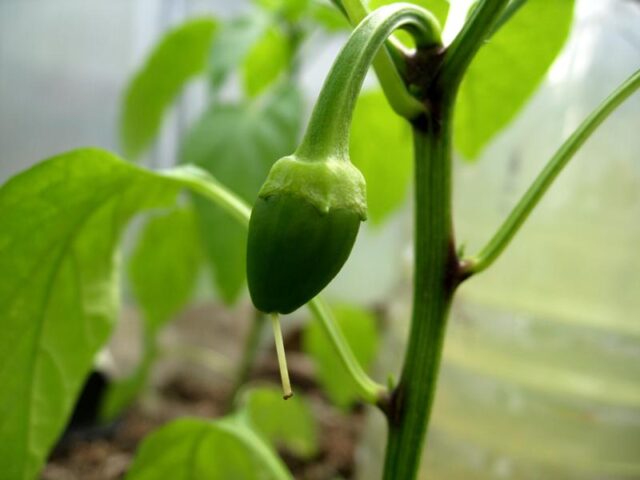
If the ovary dies, it is recommended to reduce watering and urgently fertilize the pepper.
Sunburn
In dry weather, when grown in an open area, peppers may suffer from bright sun. Yellowish spots appear on the leaves, the stem and fruits begin to dry out.
To prevent burns, cover the crop with excess sun with a light cloth or paper to protect it from ultraviolet radiation. Film cannot be used, since the bushes will be blocked under it.

To avoid sunburn, do not water or spray peppers at the height of the day.
Fruit deformation
In the absence of fungal and viral infections, pepper fruits may become deformed due to excess nitrogen in the soil.In this case, dark green or purple stripes additionally appear on the skin of vegetables.
When growing crops, it is necessary to control the amount of fertilizing and deoxidize the soil from time to time. Nitrogen is added to the soil only in early spring during the period of active development of greenery.
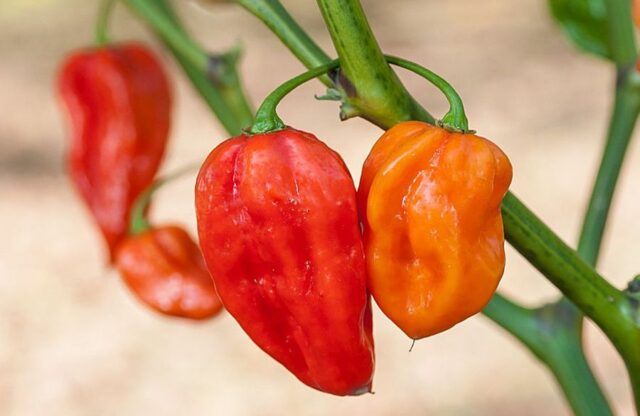
To prevent fruit deformation, peppers are fed with phosphorus and potassium.
Prevention of pepper diseases
Controlling sweet pepper diseases can be quite challenging. Therefore, you need to follow the rules to prevent most ailments:
- observe crop rotation and plant crops in one area for no longer than two years in a row;
- do not place pepper next to other nightshades;
- Every autumn, thoroughly clean the area from plant debris and dig 25 cm deep;
- control watering and prevent waterlogging of the soil.
During the growing season, pepper beds should be regularly inspected for diseases and pests. If strange spots and deformations appear on the leaves and ripening fruits, it is necessary to determine the possible cause and immediately treat the plantings.
Conclusion
Pepper diseases cannot always be successfully treated. To protect the crop from viruses and fungi, you need to focus on preventive measures and follow agricultural practices.








